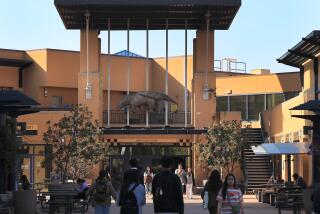Higher Learning: College achievement among Asians, Pacific Islanders varies widely

Although Asian Americans and Pacific Islanders often are portrayed as higher education success stories, a new report shows there is great disparity in college achievement among California students who belong to that community.
Those who identify as being from Chinese, Japanese, Indian, Vietnamese or Korean families tend to have significantly higher graduation rates at the UC and Cal State systems than do native Hawaiians, other Pacific Islanders and students from Laos, according to the study released Tuesday by the Campaign for College Opportunity, in partnership with Asian Americans Advancing Justice — Los Angeles.
At Cal State, for example, 66% of Chinese American students who entered in 2008 finished their degrees in six years, compared with 60% for Vietnamese and Japanese, 39% for Laotians and Guamanians, and 28% for Samoans.
Similarly wide differences were found among Asian Americans and Pacific Islanders at the state’s community colleges.
In terms of completing associate degrees and certificates or transferring to four-year schools, 73% of Chinese Americans did so within six years, as did 68% of Indians, 37% of Laotians and 29% of Samoans, the study found.
Audrey Dow, the Campaign for College Opportunity’s vice president of external affairs and operations, attributed the achievement differences to a variety of factors, including the circumstances and timing of various groups’ immigration, their income levels, families’ English proficiency and traditions of higher education.
The study also noted wide ranges in high school graduation rates, in eligibility for UC and Cal State (determined by taking the right high school classes), in acceptances to competitive campuses and other factors.
Dow said it would be misleading to lump together all Asian and Pacific Islander populations because doing so “really is masking these disparities.” Her organization is devoted to increasing college access and completion in the state.
The report released Tuesday shows that policymakers and educators “must stop treating our community as a monolithic whole,” Stewart Kwoh, president and executive director of the Asian Americans Advancing Justice-Los Angeles, a civil rights group, said in a statement.
The most disadvantaged students from parts of that population “face significant barriers to educational access and success, including high poverty and low graduation rates,” he said.
Among other things, the report called for increased state funding to expand enrollment and financial aid at public colleges and universities, better counseling in high schools and colleges, and clearer pathways to transfer from community colleges to four-year schools.
Titled “The State of Higher Education in California: Asian American, Native Hawaiian, Pacific Islander,” the report is the last in a series this year that previously looked at Latino and African American college enrollment and graduation in the state.
Most of the data come from the colleges and university systems and federal sources, including the U.S. Census Bureau, officials said.
Twitter: @larrygordonlat
MORE EDUCATION NEWS:
Study examines achievement gap between Asian American, white students
California SAT scores show 41% of test-takers are ready for college
Black and Latino students in California score better on AP tests than peers elsewhere
More to Read
Start your day right
Sign up for Essential California for news, features and recommendations from the L.A. Times and beyond in your inbox six days a week.
You may occasionally receive promotional content from the Los Angeles Times.







